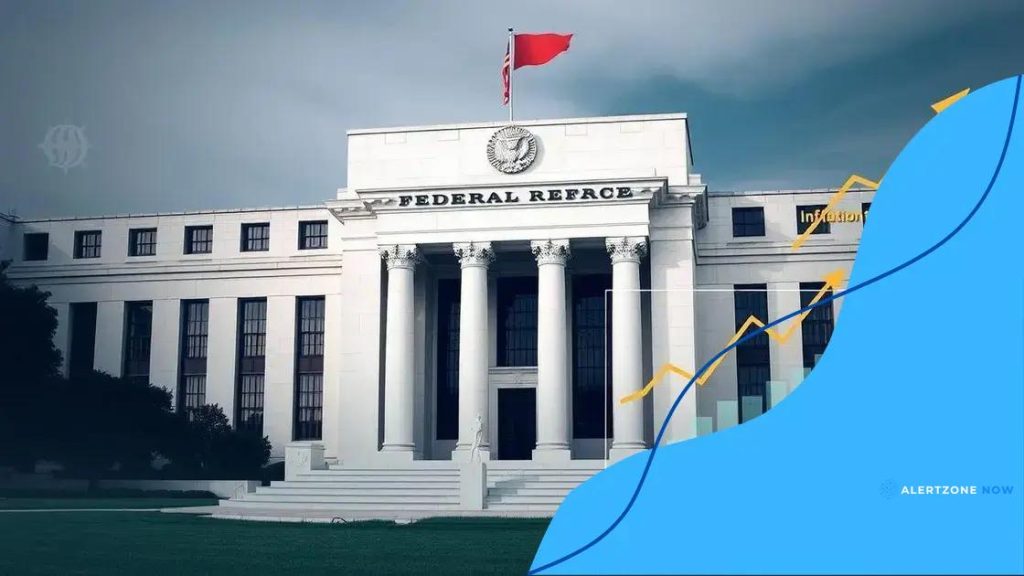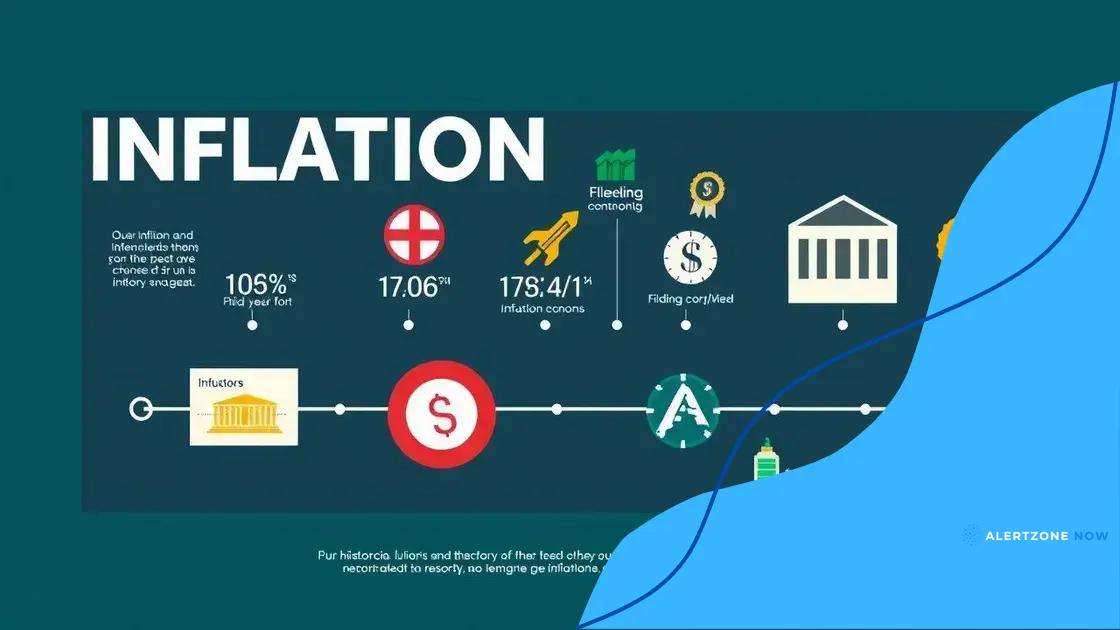Federal Reserve inflation control measures explained

Anúncios
The Federal Reserve employs various inflation control measures, such as interest rate adjustments and open market operations, to stabilize prices and promote maximum employment within the economy.
Federal Reserve inflation control measures are vital for maintaining economic stability. Have you ever wondered how these measures impact your daily life? In this article, we’ll explore their significance and influence.
Anúncios
Understanding the Federal Reserve’s role in the economy
Understanding the Federal Reserve’s role in the economy is crucial for grasping how monetary policy affects everyday life. The Federal Reserve, or the Fed, is the central bank of the United States, playing a significant role in managing the economy’s health.
The Fed influences monetary policy through various measures, including interest rate adjustments and open market operations. These actions are aimed at controlling inflation and ensuring maximum employment.
Key Functions of the Federal Reserve
There are several critical functions that the Federal Reserve serves to maintain economic stability:
Anúncios
- Regulating banks: The Fed ensures that banks operate safely and soundly.
- Setting interest rates: Adjusting rates impacts borrowing costs for individuals and businesses.
- Providing financial services: The Fed acts as a bank for the government and other financial institutions.
- Conducting monetary policy: This includes implementing strategies to manage inflation and employment levels.
The interaction of these functions helps the Federal Reserve achieve its dual mandate of promoting maximum employment and stable prices. Additionally, the Fed monitors financial stability, working to prevent systemic risks that could lead to economic downturns.
The Impact of Monetary Policy
Monetary policy impacts various aspects of the economy. When the Fed lowers interest rates, borrowing becomes cheaper, encouraging spending and investment. Conversely, raising rates can help cool down an overheated economy but may also slow down growth.
Understanding the Federal Reserve’s decisions is essential for citizens to navigate the economic landscape effectively. Changes in monetary policy can influence everything from job growth to inflation rates, making it vital for individuals to stay informed about these developments.
By following the actions and policies of the Federal Reserve, citizens can gain a better understanding of their financial environment and make informed decisions.
Key tools used for inflation control
The Federal Reserve employs several key tools for inflation control, playing a significant role in shaping the economy. These tools are vital for ensuring that inflation remains in check and that the economy functions smoothly.
One primary tool is the adjustment of interest rates. By raising or lowering the federal funds rate, the Fed influences how much it costs to borrow money. Lowering rates encourages spending and investment, while raising rates can help keep inflation down by discouraging excessive borrowing.
Open Market Operations
Another essential tool is open market operations. This involves the buying and selling of government securities in the open market. When the Fed buys securities, it adds liquidity to the economy, making money more available, which can boost spending. Conversely, selling securities absorbs excess liquidity, helping to control inflation.
- Buying securities: Increases money supply and encourages growth.
- Selling securities: Reduces money supply and helps to cool down inflation.
- Influencing expectations: Aims to manage how businesses and consumers anticipate future inflation.
Additionally, the discount rate is a tool that the Fed uses. This is the interest rate charged to commercial banks and other depository institutions for loans received from the Federal Reserve’s discount window. Changes to the discount rate can signal the Fed’s stance on monetary policy, influencing how banks set their rates.
Reserve Requirements
The Fed also adjusts reserve requirements, which dictate the amount of funds that banks must hold in reserve. A lower reserve requirement means banks can lend more, stimulating economic activity. On the other hand, increasing reserve requirements can tighten the money supply, helping to manage inflation.
By utilizing these key tools, the Federal Reserve can effectively manage inflation and support economic stability. Each tool serves a specific purpose in the broader strategy for maintaining balanced economic growth.
Historical context of inflation measures

The historical context of inflation measures is essential to understand how the Federal Reserve has responded to economic challenges over time. Throughout history, inflation has fluctuated due to various factors such as wars, oil crises, and economic booms.
In the 1970s, the U.S. faced severe inflation, partly due to the oil embargo and rising oil prices. The Fed, under Chairman Paul Volcker, took aggressive steps to combat this by significantly raising interest rates. This period saw rates exceed 20%, which aimed to curb inflation by reducing spending.
Key Historical Events
- The Great Inflation (1965-1982): A time when inflation soared, leading to rigorous monetary policies.
- The 2008 Financial Crisis: Triggered drastic measures from the Fed, including lowering rates to near-zero.
- The COVID-19 Pandemic: Prompted unprecedented fiscal and monetary responses to prevent economic collapse.
These historical events shaped the Federal Reserve’s approach to inflation control. Each response has left a mark on how inflation is perceived and managed today. For instance, the lessons learned from the Great Inflation influenced policies in the following decades. Today’s Fed uses these insights to navigate current economic landscapes.
Lessons from the Past
Understanding past inflation measures helps us see the delicate balance the Fed maintains between promoting growth and controlling inflation. When the economy is strong but faces inflation risks, the Fed’s actions can prevent long-term negative impacts. On the other hand, over-correcting can lead to recessions or slow recovery.
The ongoing challenge of balancing inflation and economic growth illustrates the complexity of the Fed’s role in the economy. By examining the historical context of inflation measures, we gain valuable insights into today’s policies and future directions.
Effects of inflation control on consumers
The effects of inflation control on consumers can be seen in various aspects of daily life. When the Federal Reserve implements measures to manage inflation, it directly impacts the economy and the purchasing power of consumers.
When inflation is kept in check, prices for goods and services tend to rise at a stable rate. This stability allows consumers to plan their budgets more effectively. For example, when people can predict how much products will cost, they feel more confident about spending their money.
Impact on Purchasing Power
Inflation control helps maintain the value of currency. If inflation rises too quickly, the purchasing power of money declines. Here are some key effects:
- Stable prices: When inflation is low, consumers can buy more with the same amount of money.
- Increased savings: Consumers are more likely to save when they don’t worry about rising prices eroding their savings.
- Improved financial planning: Predictable inflation allows families to set long-term financial goals.
Furthermore, effective inflation control leads to lower interest rates, making borrowing cheaper. This can greatly benefit consumers looking to finance major purchases such as homes or cars. A lower interest rate makes monthly payments more manageable, allowing buyers to feel more at ease with their financial decisions.
Consumer Behavior Change
When consumers believe inflation is under control, they are also more likely to spend money rather than hoard it. This behavior positively impacts economic growth since increased spending stimulates businesses and creates jobs. Conversely, when consumers anticipate rising prices, they may rush to purchase items, leading to further inflation.
Ultimately, the Federal Reserve’s actions on inflation control play a vital role in shaping the financial landscape that affects consumers. Understanding these effects helps consumers navigate their economic environment.
Future of Federal Reserve inflation strategies
The future of Federal Reserve inflation strategies is a topic of much discussion among economists and policymakers. As the economy grows and changes, so too must the methods employed to manage inflation effectively.
One potential strategy is the use of advanced analytics and technology. With big data and machine learning, the Fed could better predict inflation trends and consumer behavior. This technology can provide more accurate models that help the Fed respond quickly and efficiently to changing economic conditions.
Adapting to Economic Changes
The economy continually evolves, impacted by global events, supply chain issues, and technological advancements. The Fed may need to adjust its strategies based on these shifting factors. For example, the ongoing recovery from the pandemic has led to new challenges in inflation control.
- Rethinking interest rates: The need for flexible interest rate policies that can be adjusted based on real-time economic data.
- Inflation targeting: Setting specific inflation targets while being ready to change those targets as the economic landscape shifts.
- Global cooperation: Working with other central banks to address cross-border economic impacts, especially in trade and currency values.
Moreover, there is debate about whether the Fed should focus solely on inflation or also consider other indicators like employment and economic growth. This holistic approach may lead to a more balanced strategy that promotes overall economic health.
Public Perceptions and Communication
Effective communication will also be crucial in the future of inflation strategies. The Fed’s ability to convey its intentions and actions influences public trust and economic behavior. Clear messaging can help consumers and businesses make informed financial decisions based on expected monetary policy changes.
As we look ahead, the Fed will need to remain responsive and adaptable. The future will likely bring new challenges that demand innovative approaches to inflation control. By leveraging technology and fostering communication, the Federal Reserve can better navigate the complexities of the modern economy.
FAQ – Frequently Asked Questions about Federal Reserve Inflation Control
What is the main goal of Federal Reserve inflation control?
The main goal is to maintain stable prices and ensure maximum employment within the economy.
How does raising interest rates affect inflation?
Raising interest rates generally reduces spending and borrowing, which helps to lower inflation.
What tools does the Federal Reserve use to control inflation?
The Federal Reserve uses tools such as interest rate adjustments and open market operations to manage inflation.
What impact do inflation control measures have on consumers?
These measures help stabilize prices, which increases purchasing power and allows consumers to plan their finances more effectively.